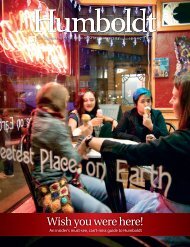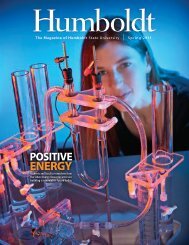Unveiled - Humboldt Magazine - Humboldt State University
Unveiled - Humboldt Magazine - Humboldt State University
Unveiled - Humboldt Magazine - Humboldt State University
You also want an ePaper? Increase the reach of your titles
YUMPU automatically turns print PDFs into web optimized ePapers that Google loves.
surprised,” Martinez says. “We’d trained them and given them<br />
the maps. It’s making them more motivated and empowered.”<br />
Meetings with local commissioners, county supervisors and<br />
ranchers followed. Officials decided to notify those within a<br />
quarter-mile of pesticide application – an option they can exercise<br />
at their discretion but which is not required. “Now, when<br />
they are going to be spraying, they [county representatives]<br />
knock on their door and tell them,” Martinez says.<br />
The project has fostered activism among all ages and<br />
genders in the affected communities. “Our group in Orosi<br />
is mostly women, and in Lindsey it’s mostly men and their<br />
fathers,” Martinez said. Youth are becoming involved, adding<br />
energy and innovation. One teen discovered a novel way<br />
to spread awareness: La lotería de los pesticidas. Based on a<br />
traditional Mexican bingo game, La lotería includes 54 cards<br />
that teach pesticide safety.<br />
The game was a hit. “It was really amazing that it came<br />
from one of the teenagers,” Martinez says.<br />
Aftermath and action<br />
THE STEINBERGS’ STUDY IS not destined to gather dust on a<br />
shelf, and the maps were not its only artifacts. A bilingual website,<br />
peopleplaceandhealth.org, offers the fruits of the project,<br />
including the maps, the final report, a booklet, testimony from<br />
interviewees and posters designed to raise awareness – all still<br />
in use by those at ground zero in pesticide country.<br />
While much remains to be done, Martinez credits Steve and<br />
Sheila Steinberg with getting the ball rolling. “Without their<br />
work, I don’t see how this would have been possible,” she says.<br />
The study provides an informed basis for more investigation<br />
into health effects of pesticide exposure, as well as<br />
legislation to create buffer zones around sensitive sites. Reforms<br />
could include better advance warning before pesticide<br />
application; creation of a database for pesticide information;<br />
establishment of buffer zones around sensitive sites; and<br />
more research into wind drift.<br />
Efforts are already underway<br />
“THEY’RE VERY SMART, THE community organizers,” Sheila<br />
said. “They’re trying to work with the owners of the farmland<br />
to come up with a solution that’s viable for both groups. They’re<br />
trying to work together.” She says she’s proud to have laid the<br />
groundwork for further studies as well as political action.<br />
Steve concurs. “For Sheila and me, that’s the main<br />
motivator – real-world research that’s not ‘ivory tower.’”<br />
A bilingual website offers maps, testimony from<br />
interviewees, awareness posters, a booklet and<br />
the full report: peopleplaceandhealth.org<br />
“A map really is worth a thousand words.”<br />
– Sheila Steinberg<br />
Total Pounds of Active<br />
Ingredients Applied<br />
Per Square MIle<br />
0<br />
1 – 5,000<br />
5,001 – 15,000<br />
15,001 – 35,000<br />
35,001 – 60,000<br />
60,000 – 143,288<br />
Schools<br />
Local Roads<br />
US Route<br />
IMAGE COURTESY OF STEVE STEINBERG<br />
This map shows reported pesticide use in areas surrounding Salinas, Calif., schools. On seeing the graphic depiction of the toxins billowing around<br />
them, parent groups and school districts have been electrified.<br />
HUMBOLDT STATE UNIVERSITY | humboldt.edu 19




